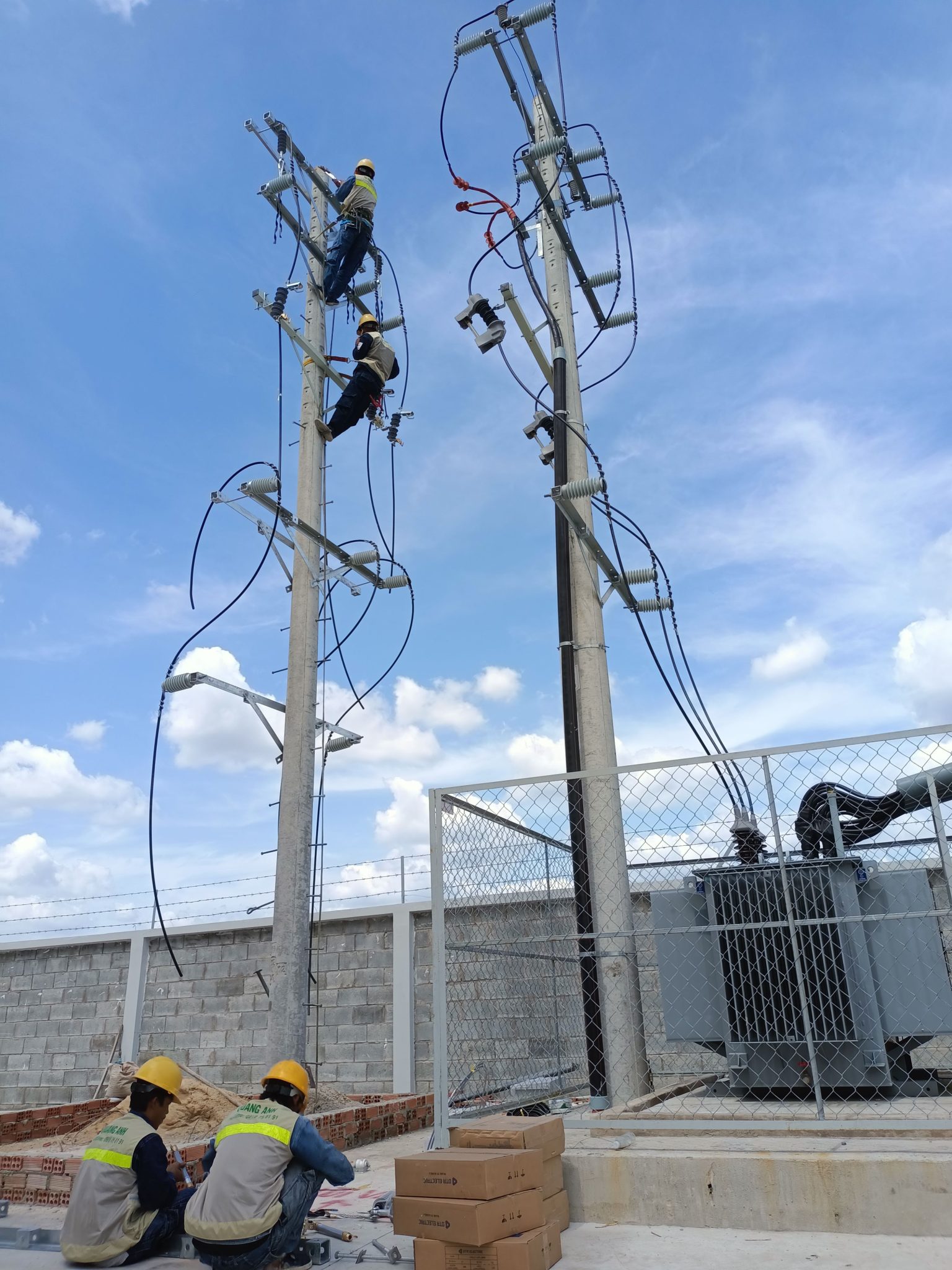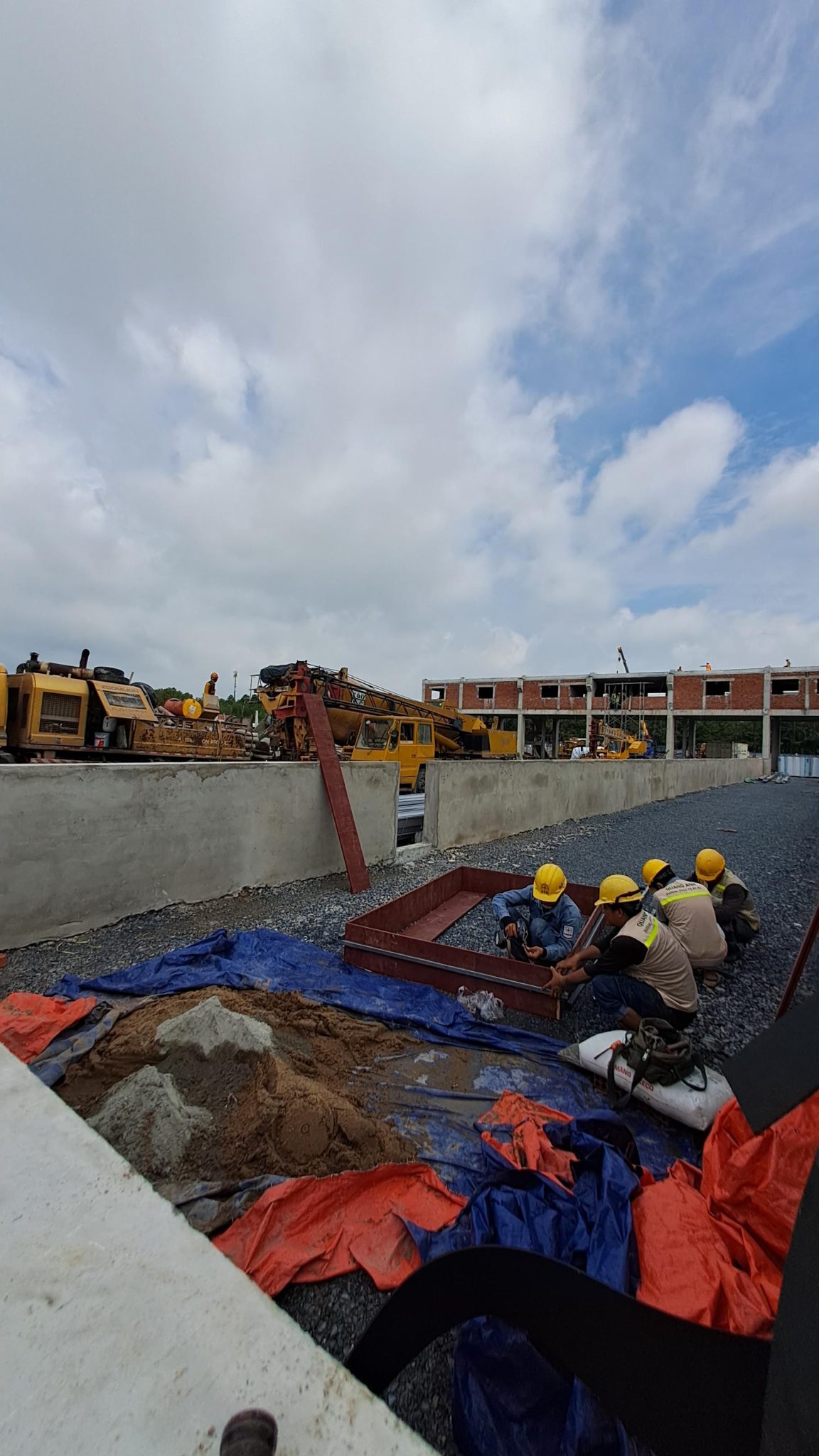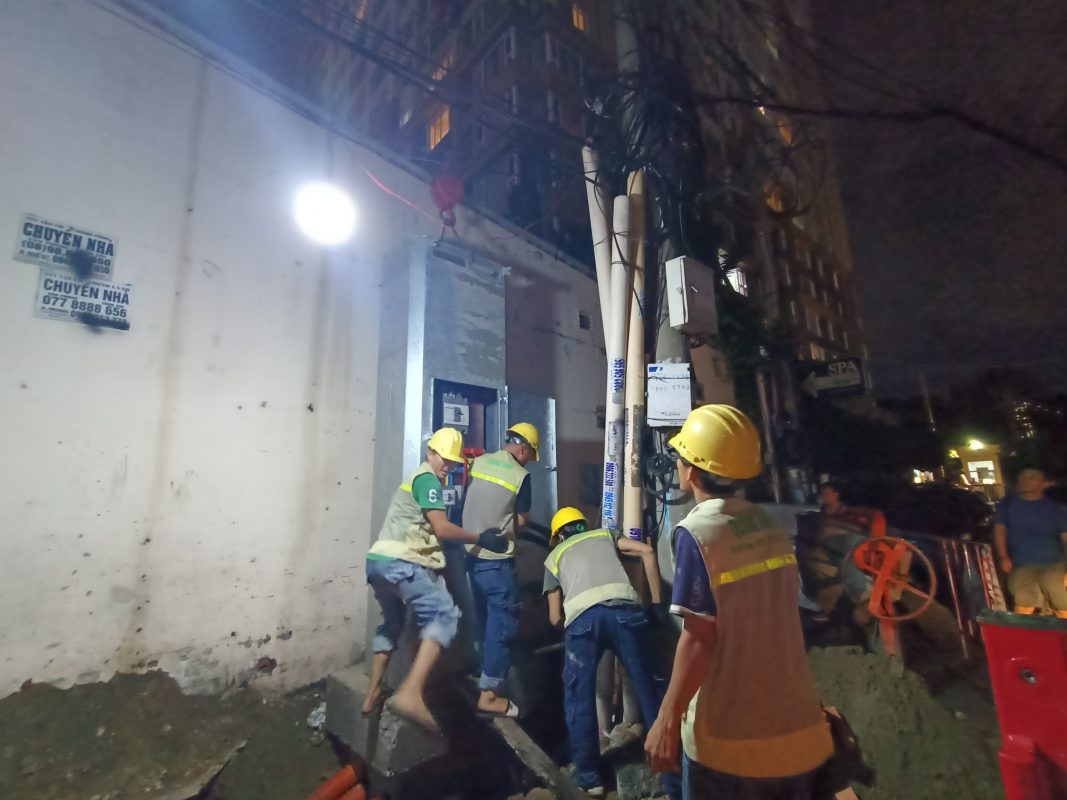The process of electrical system installation covers a range of tasks from basic to complex. This includes cost information for installing fundamental electrical appliances, integrating electrical and plumbing systems, and setting up solar energy systems.
Basic Electrical Installation Tasks
Basic electrical installations involve adding or replacing home electrical devices. This includes mounting wall lights with costs ranging from 150,000 to 300,000 VND and installing recessed lights from 150,000 to 350,000 VND. Additionally, installing or replacing surface-mounted outlets is a common procedure.
The intricate nature of basic electrical installation encompasses several essential tasks aimed at ensuring a secure, effective electrical system that adheres to strict technical standards.
- Electrical wiring and conduit installation: Laying electrical wires and conduits is the initial and fundamental step in system setup. Conduits can be routed within walls, floors or externally, based on project design. Materials like PVC or metal conduits protect and maintain system safety by routing wires from the main power source to distribution panels and end devices.
- Power panels and circuit breakers setup: Setting up main service boards, floor distribution panels, and branch panels is crucial in electrical installation. Proper connection of circuit breakers, starters, and protective devices ensures system stability and safety.
- Installation of lighting and electrical appliances: This process involves installing sockets, switches, lighting fixtures, and controllers. Connecting devices like fans, air conditioners, and water heaters is also essential.
- Cable systems and cable trays: Installation encompasses power supply and distribution cables. Cable trays offer optimal solutions for securing and protecting wiring in extensive projects.
- Lighting and low-voltage systems: Including emergency lighting, fire alarms, security cameras, and automation systems for comprehensive and secure coverage.
- Electrical system inspection and testing: Final steps involve insulation resistance checks, current and voltage measurements, and comprehensive safety testing to ensure ready and safe system operation.
Each of these tasks highlights high technical and safety standards required in electrical installation to guarantee steady and durable operation.

Electrical and Plumbing System Installation
Installing new electrical and plumbing systems typically involves various duct types. Costs can range from 105,000 VND/m2 for soft ducts to 120,000 VND/m2 for hard ducts. These common standards ensure system durability and safety.
Incorporating electrical and plumbing systems is vital in any construction project. From site surveys, design drawings to conduit installation and testing, every step must ensure precision and adhere to high technical standards. Detailed execution process includes:
Electrical System Installation
-
Survey and design: Begin by assessing site conditions and designing a suitable electrical system for specific structures, ensuring optimized functionality and meeting usage demands.
-
Conduit installation for cable protection: Implement in-wall conduit installation to safeguard wires, including underground electrical ducting if necessary.
-
Wiring and equipment positioning: Execute wiring according to design plans, prepare wall grooves, and install intermediate boxes and equipment boxes such as switches and outlets at specified locations.
-
Setup of power panels, lighting, and devices: Following wiring completion, connect and install devices as per design specifications.
-
Testing and load trials: Conduct tests, load trials, and assess soil resistivity to identify issues like shorts, ensuring maximum electrical safety when activating the system.
Plumbing System Installation
-
Preliminary survey: Evaluate existing water supply and drainage systems to determine installation conditions and locations.
-
Water supply pipe installation: Wall and technical box chipping for cold and hot water supply pipes, requiring precise fitting joint connections to ensure leak-proof systems.
-
Drain installation: Arrange waste drainage pipes from restrooms and sinks to the main drainage system after infrastructure preparation.
-
Leakage test: Use high-pressure testing methods to identify potential leaks, ensuring no water loss and preventing moisture damage.
-
Auxiliary device setup: Install storage tanks, sinks, showers, and other devices according to established technical guidelines.
Technical and Safety Standards
-
Electrical Systems: Ensure adherence to current construction standards, preventing electrical shorts or overloads. Wire installations must guarantee electrical insulation safety.
-
Water Systems: Pipes and fittings must meet pressure resistance standards, preventing leaks and ensuring correct slope for drainage systems.
Practical Experience
Based on industry knowledge, approved sequential steps from surveying, installation, checking, to commissioning help optimize efficiency and assure project quality. Special attention is given to rational design and conduit installation.
These features contribute to a complete, safe electrical and water system tailored to any project’s needs.

Solar Energy Systems
The installation cost for solar energy systems depends on various factors like system capacity and specific customer requirements. For example, a complete installation of a 5 kWp solar power system can be estimated within a certain price range, offering long-term energy cost savings.
Solar Energy represents a significant advancement towards clean, sustainable energy sources. Solar power reduces climate change impacts while providing long-term economic benefits.
Solar Technology
- Photovoltaic Technology:
- This prevalent method converts sunlight into electricity through photovoltaic cells, generating direct current power.
- Solar Cell Types:
- Monocrystalline Cells: These high-efficiency cells made of pure silicon cost more than other cell types.
- Polycrystalline Cells: Composed of multiple silicon crystals, these offer a lower efficiency at a reduced cost, ideal for budget projects.
- Cast Mono Cells: Energy-efficient production method yields lower efficiency compared to traditional monocrystalline cells.
- Advanced Technology:
- Bifacial Modules: These panels absorb light from both sides, boosting output by 5% to 30%.
- Multi Busbar: Increasing busbar numbers in panels enhances electrical conduction efficiency.
- HJT (Heterojunction Technology): This technology blends thin semiconductor layers to optimize solar energy efficiency.
Future of Solar Energy
-
Developments and Efficiency: Globally, solar energy development trends show efficiency rates reaching 20-22%, promoting sustainable growth with ongoing technical improvements.
-
Energy Storage: Investments in energy storage systems, like storage batteries, enhance solar energy utilization flexibility.
-
Future Role: Solar power will increasingly provide clean energy solutions. Policies encouraging development and research will drive this technology’s progress.

Information on electrical system installation costs offers strategies for cost-efficient projects while maximizing energy utilization across engineering and construction ventures.
To obtain detailed estimates for your project, contact QuangAnhcons at +84 9 1975 8191 today.
QuangAnhcons provides comprehensive electrical installation services, including basic and solar options, with skilled technicians and competitive pricing.
[contact-form-7 id="7239967" title="Contact form 1"]


Related Posts
Tay Ninh Solar Power Planning: Technical Framework, Grid Interconnection, and Rollout Roadmap
Technical overview of solar planning in Tay Ninh: irradiation, grid capacity, permitting, design, operations, and [...]
Dec
Binh Duong Solar Planning: Regulatory Framework, Grid Interconnection, and an Implementation Roadmap for Factories and Industrial Parks
An overview of Binh Duong solar planning: legal framework, interconnection, design, risk management, and an [...]
Dec
Solar Farm Repair: O&M Workflow, IV Curve Diagnostics, Thermography, Inverter Service and Utility-Scale Safety
A utility-scale solar farm repair plan centered on O&M, IV curves, thermal imaging, inverter service, [...]
Dec
Dong Nai Solar Power Plan 2023–2025: Tri An 1,029 MW, Grid Upgrades and the DPPA Pathway
A complete look at Dong Nai’s solar power plan: Tri An 1,029 MW, irradiation potential, [...]
Nov
Quang Ngai Solar Power Plan 2024–2030: Legal Framework, Irradiance Potential, and Development Roadmap
A complete look at Quang Ngai’s solar power plan: capacity targets, irradiance (PVout), development zones, [...]
Nov
Solar Damage Assessment Services: On-Site Procedures, EL/IV/Thermography Testing & Compliance with Standards
Discover IEC/UL/NEC standard solar damage assessment processes: on-site evaluation, EL and IV curve testing, thermal [...]
Nov
Comprehensive Package Estimate for a 1800MVA 500kV Substation: Scope, Configuration 3x600MVA, Standards and Timeline Management
An overview of the 1800MVA 500kV substation estimate: construction scope, configuration 3x600MVA, GIS/AIS, SCADA, standards, [...]
Nov
Factory Electrical Systems: Comprehensive Design and Implementation Guide
Discover the detailed and safe process of factory electrical systems design and implementation. [...]
Oct
Blueprints Required for Factory Construction Permits
Discover the necessary blueprints in factory construction permit applications, from floor plans to electrical and [...]
Oct
What Are the Requirements for a Factory Construction Permit? A Comprehensive Guide
Explore the documentation and steps needed to secure a factory construction permit for streamlined project [...]
Oct
Factory Construction Permit Procedures in Vietnam: Essential Guidelines and Documents
Learn the procedures for securing a factory construction permit in Vietnam, focusing on document preparation [...]
Oct
Key Steps in the Factory Construction Process
Discover the essential steps and requirements for building factories. [...]
Oct
Comprehensive Electrical Substation Solutions by Quanganhcons
Discover the cutting-edge electrical substation solutions offered by Quanganhcons for industrial applications. [...]
Oct
Investment Costs for a 1MWp Solar Power System and Influencing Factors
Explore the investment costs for a 1MWp solar power system in Vietnam and the influencing [...]
Sep
QuangAnhcons: Elevating Wind Energy Solutions
Explore QuangAnhcons' leadership in wind energy and renewable solutions in Vietnam. [...]
Sep
Electrical Contractor Strategies at Becamex Industrial Park
Discover the strategic advancements and partnerships of the electrical contractor at Becamex Industrial Park. [...]
Sep
Investment Insights for 1MW Wind Energy in Vietnam: Costs and Opportunities
Discover the detailed analysis of costs and opportunities for investing in 1MW wind energy projects [...]
Sep
Advanced Electrical Installation Solutions by QuangAnhcons
Explore advanced electrical installation solutions and modern technology with QuangAnhcons. [...]
Sep
Enhancing Industrial Electrical Services with Quanganhcons
Discover Quanganhcons' expertise in industrial electrical services, offering efficient and sustainable power systems. [...]
Sep
Comprehensive MEP Solutions by QuangAnhcons: From Design to Maintenance Excellence
Discover optimal MEP solutions with QuangAnhcons, dedicated to excellence from design through maintenance. [...]
Sep